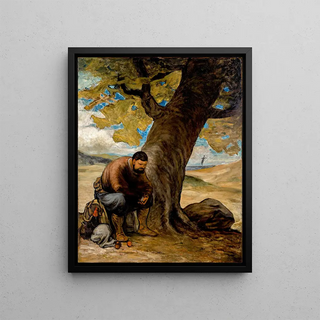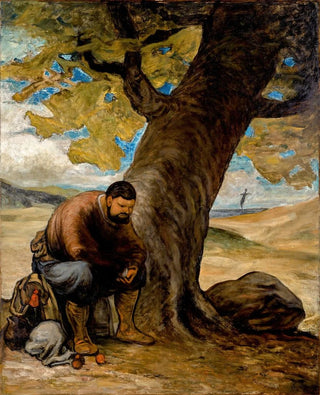Art print | Sancho Panza resting under a tree - Honoré Daumier


View from behind

Frame (optional)
Sancho Panza resting under a tree - Honoré Daumier – Captivating Introduction
In the rich and complex universe of art, some works manage to capture the very essence of humanity through simple yet evocative scenes. "Sancho Panza resting under a tree" by Honoré Daumier is one of those creations that transports the viewer to a moment of pause, reflection, and introspection. This piece, depicting the famous companion of Don Quixote, embodies both lightness and depth, blending everyday life with philosophy. Through this art print, the artist evokes universal emotions while immersing us in Cervantès' literary universe, where humor and melancholy coexist effortlessly.
Style and uniqueness of the work
Honoré Daumier's style is distinguished by his ability to combine realism and caricature, a duality that is vividly expressed in "Sancho Panza resting under a tree." The depiction of Sancho, seated in the benevolent shade of a tree, conveys a moment of respite in a often tumultuous world. The character's features, both expressive and simple, reveal the depth of his personality. Daumier excels in capturing the moment, and this art print demonstrates his skill in immortalizing subtle emotions through gestures and postures. Light and shadow play a crucial role, creating an atmosphere of tranquility that invites contemplation. This painting is an invitation to pause, to reflect on the meaning of rest and life, while highlighting the beauty of fleeting moments.
The artist and his influence
Honoré Daumier, born in 1808, is an emblematic figure of the 19th century, recognized not only for his talent as a painter but also for his commitment as a caricaturist and lithographer. His work is often marked by a critical eye on the society of his time, but he also knew how to celebrate the small joys of daily life. Daumier established himself as a witness of his era, depicting with finesse the vices of the bourgeoisie and the struggles of the working classes. His influence extends

Matte finish

View from behind

Frame (optional)
Sancho Panza resting under a tree - Honoré Daumier – Captivating Introduction
In the rich and complex universe of art, some works manage to capture the very essence of humanity through simple yet evocative scenes. "Sancho Panza resting under a tree" by Honoré Daumier is one of those creations that transports the viewer to a moment of pause, reflection, and introspection. This piece, depicting the famous companion of Don Quixote, embodies both lightness and depth, blending everyday life with philosophy. Through this art print, the artist evokes universal emotions while immersing us in Cervantès' literary universe, where humor and melancholy coexist effortlessly.
Style and uniqueness of the work
Honoré Daumier's style is distinguished by his ability to combine realism and caricature, a duality that is vividly expressed in "Sancho Panza resting under a tree." The depiction of Sancho, seated in the benevolent shade of a tree, conveys a moment of respite in a often tumultuous world. The character's features, both expressive and simple, reveal the depth of his personality. Daumier excels in capturing the moment, and this art print demonstrates his skill in immortalizing subtle emotions through gestures and postures. Light and shadow play a crucial role, creating an atmosphere of tranquility that invites contemplation. This painting is an invitation to pause, to reflect on the meaning of rest and life, while highlighting the beauty of fleeting moments.
The artist and his influence
Honoré Daumier, born in 1808, is an emblematic figure of the 19th century, recognized not only for his talent as a painter but also for his commitment as a caricaturist and lithographer. His work is often marked by a critical eye on the society of his time, but he also knew how to celebrate the small joys of daily life. Daumier established himself as a witness of his era, depicting with finesse the vices of the bourgeoisie and the struggles of the working classes. His influence extends






